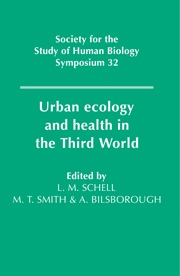Book contents
- Frontmatter
- Contents
- List of contributors
- Acknowledgements
- 1 Human biological approaches to the study of Third World urbanism
- 2 Social and cultural influences in the risk of cardiovascular disease in urban Brazil
- 3 The urban disadvantage in the developing world and the physical and mental growth of children
- 4 Differences in endocrine status associated with urban-rural patterns of growth and maturation in Bundi (Gende-speaking) adolescents of Papua New Guinea
- 5 Nutritionally vulnerable households in the urban slum economy: a case study from Khulna, Bangladesh
- 6 Urban-rural differences in growth and diarrhoeal morbidity of Filipino infants
- 7 Child health and growth in urban South Africa
- 8 From countryside to town in Morocco: ecology, culture and public health
- 9 Urban-rural population research: a town like Alice
- 10 Selection for rural-to-urban migrants in Guatemala
- 11 Health and nutrition in Mixtec Indians: factors influencing the decision to migrate to urban centres
- 12 Urban health and ecology in Bunia, N.E. Zaire, with special reference to the physical development of children
- 13 Food for thought: meeting a basic need for low-income urban residents
- 14 Immunological parameters in northeast Arnhem Land Aborigines: consequences of changing settlement patterns and lifestyles
- 15 Amerindians and the price of modernisation
- 16 Sex ratio determinants in Indian populations: studies at national, state and district levels
- 17 Polarisation and depolarisation in Africa
- 18 Urbanisation in the Third World: health policy implications
- Index
5 - Nutritionally vulnerable households in the urban slum economy: a case study from Khulna, Bangladesh
Published online by Cambridge University Press: 26 December 2009
- Frontmatter
- Contents
- List of contributors
- Acknowledgements
- 1 Human biological approaches to the study of Third World urbanism
- 2 Social and cultural influences in the risk of cardiovascular disease in urban Brazil
- 3 The urban disadvantage in the developing world and the physical and mental growth of children
- 4 Differences in endocrine status associated with urban-rural patterns of growth and maturation in Bundi (Gende-speaking) adolescents of Papua New Guinea
- 5 Nutritionally vulnerable households in the urban slum economy: a case study from Khulna, Bangladesh
- 6 Urban-rural differences in growth and diarrhoeal morbidity of Filipino infants
- 7 Child health and growth in urban South Africa
- 8 From countryside to town in Morocco: ecology, culture and public health
- 9 Urban-rural population research: a town like Alice
- 10 Selection for rural-to-urban migrants in Guatemala
- 11 Health and nutrition in Mixtec Indians: factors influencing the decision to migrate to urban centres
- 12 Urban health and ecology in Bunia, N.E. Zaire, with special reference to the physical development of children
- 13 Food for thought: meeting a basic need for low-income urban residents
- 14 Immunological parameters in northeast Arnhem Land Aborigines: consequences of changing settlement patterns and lifestyles
- 15 Amerindians and the price of modernisation
- 16 Sex ratio determinants in Indian populations: studies at national, state and district levels
- 17 Polarisation and depolarisation in Africa
- 18 Urbanisation in the Third World: health policy implications
- Index
Summary
Introduction
It has been established that undernutrition is not randomly distributed within a given population, but is a dimension of poverty (Basta, 1977; Hussain & Lunven, 1987; Lipton, 1983; Nabarro, 1984; Payne, 1987; Rao, 1985; Reichmanheim, 1988; Sukhatme, 1981; UNICEF, 1981). The ability of a household to command sufficient food resources is primarily dependent upon social and economic variables such as assets, employment and income.
In urban areas, households are often characterised by a dependence upon the market, not only for employment and food, but also for other basic needs. Several studies conducted in urban areas of developing countries have indicated undernutrition in children to be associated with low effective income (Aguillon et al., 1985; Azevedo, 1989; Mazur & Sanders, 1988; Murillo-Gonzalez, 1983; Victora et al., 1986; Wray & Aguirre, 1969), low levels of food expenditure (Wray & Aguirre, 1969), low levels of ownership of consumer durables (Azevedo, 1989; Pickering et al., 1985), or low levels on composite socioeconomic scores (Christiansen et al., 1975; Greiner & Latham, 1981; Zeitlin et al., 1978).
Rarely have such studies attempted to identify the types of urban livelihoods associated with low income and undernutrition. The aim of this paper is to describe patterns of household economic livelihood in one inner-city slum in the city of Khulna, Bangladesh, and to identify those patterns of livelihood that were most closely associated with nutritional vulnerability among both children and adults.
- Type
- Chapter
- Information
- Urban Ecology and Health in the Third World , pp. 61 - 74Publisher: Cambridge University PressPrint publication year: 1993
- 3
- Cited by



